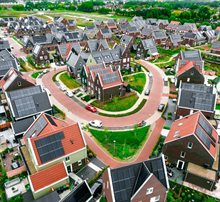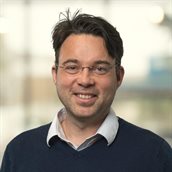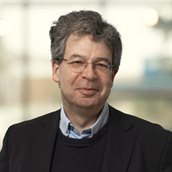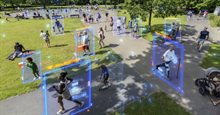The signatures for ATELIER were placed in 2019. In the process, Amsterdam and Bilbao, Spain, presented themselves as so-called Lighthouse Cities. These two cities pledged to do everything in their power to make Positive Energy Districts a reality. Their experiences of the project are then shared with six Fellow Cities. These are Copenhagen (Denmark), Bratislava (Slovakia), Budapest (Hungary), Krakow (Poland), Matosinhos (Portugal), and Riga (Latvia).
What exactly are Positive Energy Districts?
Of course, all those signatures and promises are a good thing. But what exactly are Positive Energy Districts? The short answer is that they’re districts in large cities that produce at least as much renewable energy as they consume. In other words, they generate a net positive result in terms of their energy usage. Wherever possible, the districts are also replacing fossil fuels with renewable alternatives. To this end, three focal points have been identified:
- Reduce energy consumption as much as possible.
- Increase the production of renewable energy.
- Design and manage the energy system in a smart way.
Although clear and straightforward, these focal points are obviously challenging to achieve in the complex realities of large cities. This is why it’s key for cities to share their experiences with the Positive Energy Districts with each other.
Amsterdam is a Lighthouse City, which gives its citizens an important role
Amsterdam is not only one of the Lighthouse Cities within the ATELIER project but has also been responsible for coordinating the project from the outset. To fulfil this role, it was not long before our capital enlisted the help of TNO Vector.
Project Manager Jeroen Brouwer reflects: ‘We were asked to write the project proposal. And from the very first concept, we’ve made out a case for creating a solid network. With complex innovation projects of this kind, it’s essential to work with the right people with the right knowledge from the start.’
‘Collaboration should not be limited to the public and private sector, experts, and knowledge institutions, but also citizens have an important role to play. This is the best way to achieve a fertile breeding ground for something really beautiful to grow.’ - Jeroen Brouwer, project manager at TNO Vector
Buiksloterham, Amsterdam
‘Growth’ may not be the best word in this context; ‘building’ is a more appropriate term. Because, in order to become a Positive Energy District, a district first needs to undergo a major overhaul. The designated Positive Energy District in Amsterdam is Buiksloterham. This area, which mainly consists of businesses and industry, has already been undergoing a wider transformation.
Two new mixed-use buildings are currently being built in Buiksloterham. They are expected to be climate-neutral through the following innovations and measures:
- Green roofs.
- Low-emission materials.
- Solar panels.
- A smart energy grid.
- Large batteries for energy storage.
An Energy Market Platform has been set up for when residents and other users move into these buildings. This platform enables people to distribute and trade energy locally. The developer has also set up an Energy Community to monitor energy consumption and production, and to exchange and manage transactions.
Zorrotzaurre, Bilbao
As a Lighthouse City, Amsterdam is thus enthusiastically embracing its pioneering role. The same goes for Bilbao. Bilboa’s intended Positive Energy District is in Zorrotzaurre, the former industrial heart of the old city. A peninsula for centuries, Zorrotzaurre became an island in 2018, one year before the start of the ATELIER project. It’s the perfect place to test sustainable concepts and principles.
In the future, 5,500 homes and 150,000 square metres of office space are to be built in Zorrotzaurre. The island will be emission-free, only accessible to zero-emission vehicles. And its public transport system will be entirely powered by electricity. The island is divided into three areas, connected by a system that exchanges geothermal and aquathermal energy. Through this system, surpluses are sent to other parts of the city.
Getting used to a new form of collaboration
Developers are not only struggling with the technological challenges of developing Positive Energy Districts; their organisation is also proving to be complex.
‘The establishment of an Energy Community is a new concept, the legal and financial aspects of which are quite complicated. In addition to public and private funding, part of the funding comes from members of the Energy Community.’ - Jurgen van der Heijden, senior consultant at TNO Vector
Project Manager Jeroen Brouwer adds: ‘This is an interesting development since we are used to two types of money – public and private. Now, a new type – private, or so-called 'civil money' – is being introduced, which is money invested by users. The advantage is that there is more money available. The downside is that a collective of users investing together gain a lot of the decision-making power. This requires different arrangements to be made. It’s incredibly important that all parties involved communicate well together and are willing to share their knowledge with each other. This new form of collaboration is something the public and private sectors really need to get used to.’
Making important choices in advance
Jurgen van der Heijden picks up the conversation again: ‘However, it’s true that the cooperative is a traditionally known organisational form in the Netherlands. It’s not a bad foundation for establishing an Energy Community. An additional challenge, however, is that the creation of a Positive Energy District requires important choices to be made in advance, at a time when there aren’t any residents or users who will collectively form an Energy Community.’
This means that the parties involved in the development of such an area carry a great responsibility. Which choices will you make in terms of insulation, renewable energy generation, smart grid technology, mobility, and energy storage? These are not things you can ‘simply fix’ after the buildings and infrastructures are already in place.
Security of supply
For this reason, the developer decided to set up its own cooperative in Buiksloterham. ‘But that introduces other problems’, Van der Heijden explains. ‘For example, although the European Union had already adopted directives facilitating the creation of small energy networks at the building level in 2021, all sorts of wrinkles still need to be ironed out before that legislation is applicable in practice.’
A key discussion point is what exactly is meant by the security of supply concept since it is a strict requirement from both the Dutch national government and the Dutch Authority for Consumers and Markets (ACM). Van der Heijden: ‘That requirement is understandable. Of course, no one intends to leave building occupants and users without power unexpectedly. This is also why large batteries for energy storage will be used for the buildings in Buiksloterham. In this way, there’s always a buffer.’
Learning from each other in the ATELIER project
The European directives for proprietary energy networks naturally also apply to the seven other cities participating in the ATELIER project. Discussing regulations amongst each other quickly reveals how great the differences between countries are. The same applies to the choice of certain innovations or forms of organisation. This was also evident during the various Innovation Ateliers. These sessions, which centre around one specific topic, are intended to find out where the bottlenecks and solutions lie.
Learning from each other is not one-way traffic. The Lighthouse Cities are also learning from the Fellow Cities. Jeroen Brouwer: ‘Take the concept of the energy service company (ESCO) as an example. Like in other countries this is a hot topic in the Netherlands. It appeared, however, that the concept, which involves a company making an upfront investment in sustainable solutions with an end user and then recouping that investment through savings, is a way of working that has already been in place in Slovakia for around 20 years. I thought that was pretty striking.’
Van der Heijden also cites examples of differences: ‘On the other hand, the idea of the cooperative is especially strong in north-western Europe. In this respect, the Netherlands can demonstrate the benefits of this organisational form in terms of governance and the business case.’
ATELIER annual meeting
The cities involved in the ATELIER project exchange knowledge digitally. The parties also meet annually. This year’s meeting was held in Riga. ‘It’s all very cutting edge. So it’s important to spend a few days exchanging views and discussing the learning points together’, stresses Brouwer.
Van der Heijden adds: ‘We felt that the Energy Community and the investment platform needed some extra attention. So I went into a little more detail about them during a presentation. And judging by the questions I have since received, it seems clear that the bottlenecks are often in the legal and financial realms. It would be good to gain more clarity in those areas soon. Because without that clarity, many parties will remain afraid to take the steps needed to realise Positive Energy Districts – let alone create climate-neutral cities.’
TNO’s contribution to ATELIER was made by: Jeroen Brouwer, Jurgen van der Heijden, Geiske Bouma, Eva Winters, Devin Diran, Wouter Borsboom, and Ruud van der Linden.





